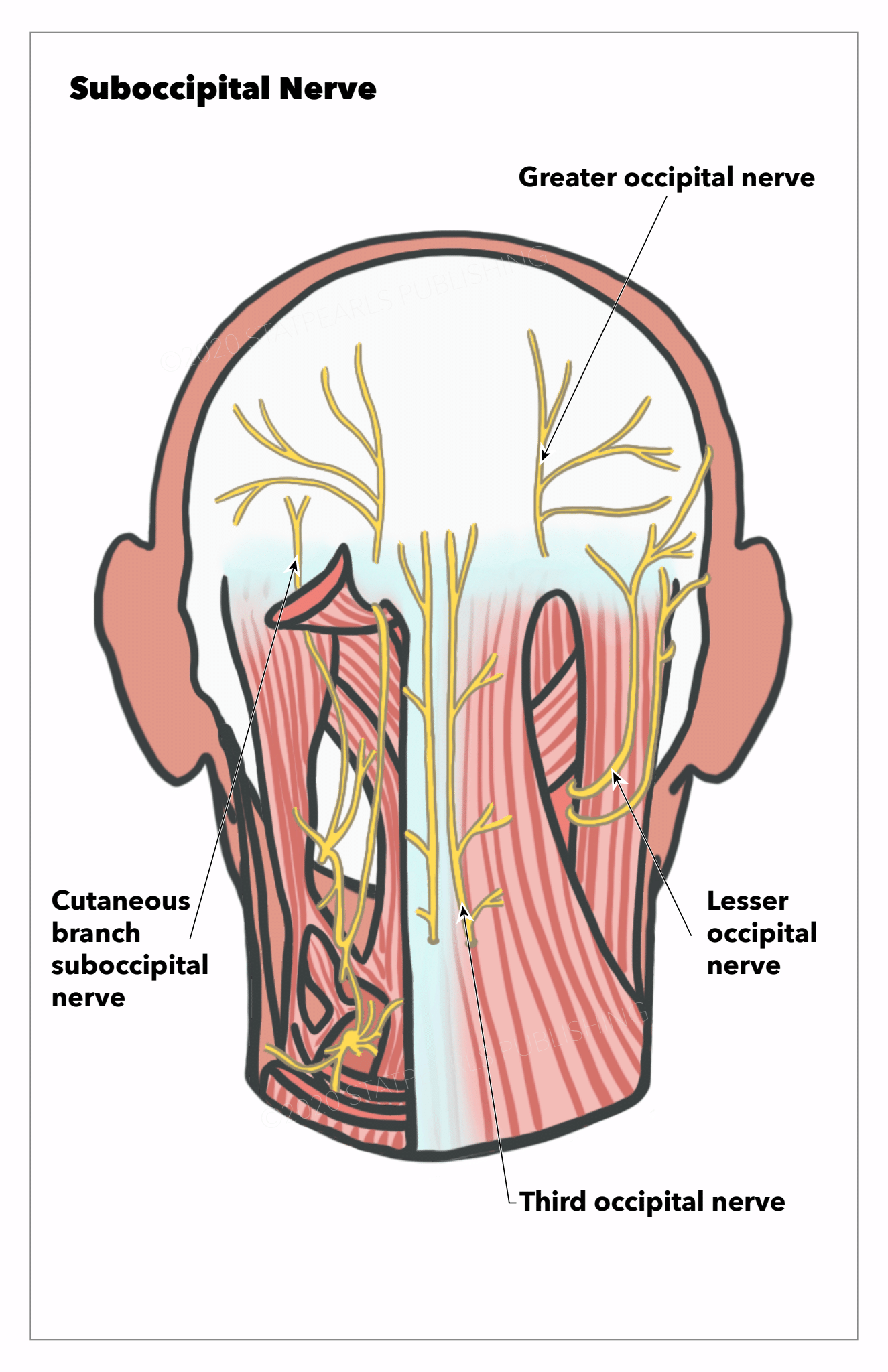[1]
La Rocca G,Altieri R,Ricciardi L,Olivi A,Della Pepa GM, Anatomical study of occipital triangles: the 'inferior' suboccipital triangle, a useful vertebral artery landmark for safe postero-lateral skull base surgery. Acta neurochirurgica. 2017 Oct;
[PubMed PMID: 28828558]
[2]
Gutierrez S,Huynh T,Iwanaga J,Dumont AS,Bui CJ,Tubbs RS, A Review of the History, Anatomy, and Development of the C1 Spinal Nerve. World neurosurgery. 2020 Mar;
[PubMed PMID: 31838236]
[4]
Maschner A,Krück S,Draga M,Pröls F,Scaal M, Developmental dynamics of occipital and cervical somites. Journal of anatomy. 2016 Nov;
[PubMed PMID: 27380812]
[5]
Loukas M,Tubbs RS, An accessory muscle within the suboccipital triangle. Clinical anatomy (New York, N.Y.). 2007 Nov;
[PubMed PMID: 17415745]
[6]
Tagil SM,Ozçakar L,Bozkurt MC, Insight into understanding the anatomical and clinical aspects of supernumerary rectus capitis posterior muscles. Clinical anatomy (New York, N.Y.). 2005 Jul;
[PubMed PMID: 15971221]
Level 3 (low-level) evidence
[7]
Nayak SR,Swamy R,Krishnamurthy A,Dasgupta H, Bilateral anomaly of rectus capitis posterior muscles in the suboccipital triangle and its clinical implication. La Clinica terapeutica. 2011;
[PubMed PMID: 21912824]
[8]
Eskander MS, Drew JM, Aubin ME, Marvin J, Franklin PD, Eck JC, Patel N, Boyle K, Connolly PJ. Vertebral artery anatomy: a review of two hundred fifty magnetic resonance imaging scans. Spine. 2010 Nov 1:35(23):2035-40. doi: 10.1097/BRS.0b013e3181c9f3d4. Epub
[PubMed PMID: 20938397]
[9]
Berguer R, Suboccipital approach to the distal vertebral artery. Journal of vascular surgery. 1999 Aug;
[PubMed PMID: 10436455]
[10]
Tubbs RS,Loukas M,Slappey JB,Shoja MM,Oakes WJ,Salter EG, Clinical anatomy of the C1 dorsal root, ganglion, and ramus: a review and anatomical study. Clinical anatomy (New York, N.Y.). 2007 Aug;
[PubMed PMID: 17330847]
[11]
Jhawar SS,Nunez M,Pacca P,Voscoboinik DS,Truong H, Craniovertebral junction 360°: A combined microscopic and endoscopic anatomical study. Journal of craniovertebral junction
[PubMed PMID: 27891029]
[12]
Mingdong W,Fernandez-Miranda JC,Mathias RN,Wang E,Gardner P,Wang H, Fully Endoscopic Minimally Invasive Transrectus Capitis Posterior Muscle Triangle Approach to the Posterolateral Condyle and Jugular Tubercle. Journal of neurological surgery. Part B, Skull base. 2017 Oct;
[PubMed PMID: 28875113]
[13]
Nonaka M,Yagi K,Abe H,Miki K,Morishita T,Iwaasa M,Inoue T, Endoscopic surgery via a combined frontal and suboccipital approach for cerebellar hemorrhage. Surgical neurology international. 2018;
[PubMed PMID: 29721347]
[14]
Bocchetti A,Cioffi V,Gragnaniello C,de Falco R, Versatility of sub-occipital approach for foramen magnum meningiomas: a single centre experience. Journal of spine surgery (Hong Kong). 2017 Sep
[PubMed PMID: 29057351]
[15]
Tatagiba M,Koerbel A,Roser F, The midline suboccipital subtonsillar approach to the hypoglossal canal: surgical anatomy and clinical application. Acta neurochirurgica. 2006 Sep
[PubMed PMID: 16817032]
[16]
Naderi S,Usal C,Tural AN,Korman E,Mertol T,Arda MN, Morphologic and radiologic anatomy of the occipital bone. Journal of spinal disorders. 2001 Dec;
[PubMed PMID: 11723399]
[17]
Park SK,Yang DJ,Kim JH,Heo JW,Uhm YH,Yoon JH, Analysis of mechanical properties of cervical muscles in patients with cervicogenic headache. Journal of physical therapy science. 2017 Feb;
[PubMed PMID: 28265168]
[18]
Sillevis R,Hogg R, Anatomy and clinical relevance of sub occipital soft tissue connections with the dura mater in the upper cervical spine. PeerJ. 2020;
[PubMed PMID: 32864219]
[19]
Bogduk N, The anatomical basis for cervicogenic headache. Journal of manipulative and physiological therapeutics. 1992 Jan;
[PubMed PMID: 1740655]
[20]
Sadashivaiah J,Wilson R,McLure H,Lyons G, Double-space combined spinal-epidural technique for elective caesarean section: a review of 10 years' experience in a UK teaching maternity unit. International journal of obstetric anesthesia. 2010 Apr
[PubMed PMID: 19945843]
[21]
Malhotra S. All patients with a postdural puncture headache should receive an epidural blood patch. International journal of obstetric anesthesia. 2014 May:23(2):168-70. doi: 10.1016/j.ijoa.2014.01.001. Epub 2014 Jan 18
[PubMed PMID: 24656528]
[22]
Thew M, Paech MJ. Management of postdural puncture headache in the obstetric patient. Current opinion in anaesthesiology. 2008 Jun:21(3):288-92. doi: 10.1097/ACO.0b013e3282f8e21a. Epub
[PubMed PMID: 18458543]
Level 3 (low-level) evidence
[23]
Girma T, Mergia G, Tadesse M, Assen S. Incidence and associated factors of post dural puncture headache in cesarean section done under spinal anesthesia 2021 institutional based prospective single-armed cohort study. Annals of medicine and surgery (2012). 2022 Jun:78():103729. doi: 10.1016/j.amsu.2022.103729. Epub 2022 May 7
[PubMed PMID: 35600186]
[24]
Abdelraouf M,Salah M,Waheb M,Elshall A, Suboccipital Muscles Injection for Management of Post-Dural Puncture Headache After Cesarean Delivery: A Randomized-Controlled Trial. Open access Macedonian journal of medical sciences. 2019 Feb 28;
[PubMed PMID: 30894910]
Level 1 (high-level) evidence
[25]
Fakhran S,Qu C,Alhilali LM, Effect of the Suboccipital Musculature on Symptom Severity and Recovery after Mild Traumatic Brain Injury. AJNR. American journal of neuroradiology. 2016 Aug
[PubMed PMID: 27012296]
[26]
Hack GD, Koritzer RT, Robinson WL, Hallgren RC, Greenman PE. Anatomic relation between the rectus capitis posterior minor muscle and the dura mater. Spine. 1995 Dec 1:20(23):2484-6
[PubMed PMID: 8610241]
[28]
Moraska AF, Schmiege SJ, Mann JD, Butryn N, Krutsch JP. Responsiveness of Myofascial Trigger Points to Single and Multiple Trigger Point Release Massages: A Randomized, Placebo Controlled Trial. American journal of physical medicine & rehabilitation. 2017 Sep:96(9):639-645. doi: 10.1097/PHM.0000000000000728. Epub
[PubMed PMID: 28248690]
Level 1 (high-level) evidence
[29]
Cohen SP. Epidemiology, diagnosis, and treatment of neck pain. Mayo Clinic proceedings. 2015 Feb:90(2):284-99. doi: 10.1016/j.mayocp.2014.09.008. Epub
[PubMed PMID: 25659245]


